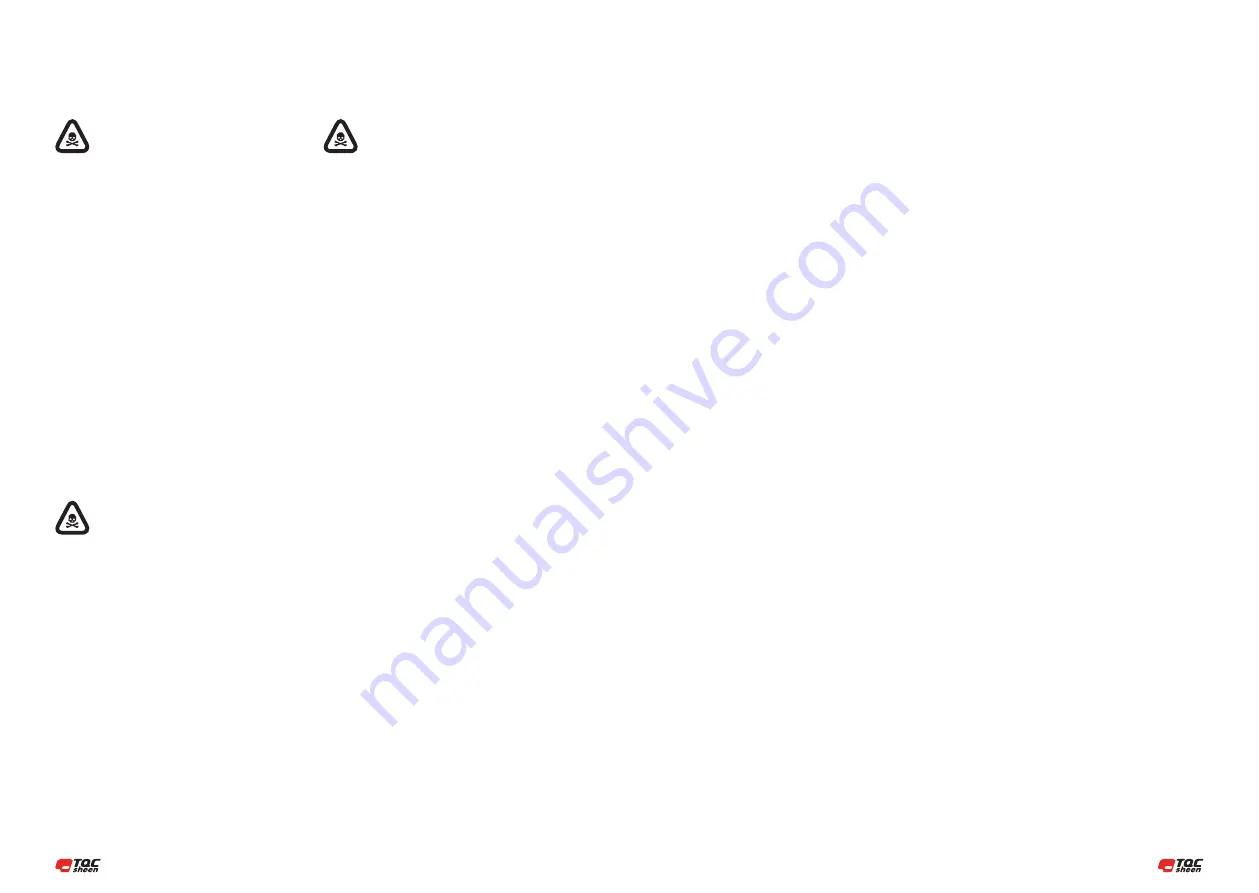
| 8
9 |
2.4 Dangers from invisible optical radiation
WARNING! Danger to health from invisible optical
radiation! Irradiation of the skin close to the exit
hole can lead to light burns.
• The red light spots are only an aid and serve to
focus the measuring point. They light up when the
equipment is configured and ready to measure.
The excitation beam itself is slightly blue!
• Never point the excitation beam directly at eyes
and skin.
• Never observe the excitation beam with optical
instruments such as lenses and microscopes.
• Long time exposure to radiation (over 60s daily)
may lead to skin damages. When working in the
path of the beam the use of protective gloves is
recommended.
• Only switch on the equipment if the sensor’s beam
exit hole has been tested for external damage.
• If the sensor is damaged, do not continue to use
the measuring equipment and send it immediately
to TQC Sheen.
WARNING! Danger to life from fire caused by heat
generated by the excitation beam!The excitation
beam can set flammable solids, liquids and gases
on fire and cause severe to fatal injuries.
• Never use the excitation beam in areas where
there is a risk of explosion.
• Never point the measuring equipment at
flammable materials.
2.5 Dangers when handling Li-ion batteries
WARNING! The accompanying 14500 Lithium
ion batteries are impermeable to gases and
non-harmful as long as the manufacturers’
requirements for use and handling are obeyed.
Improper handling of the rechargeable battery,
especially mechanical damage or charging with
an unsuitable battery charger can lead to it
catching fire or exploding.
• Avoid mechanical and thermal stresses. Mechanical
damage can lead to internal short-circuits. Fire risk!
• Protect batteries from damp. In case of fire, do not
extinguish it with with water, but with sand, say.
• Electrolyte solution is highly flammable. Leaked
electrolyte solution from a Li-ion battery can be
washed away from the battery with water.
• Do not short-circuit Li-ion batteries. Take care
when using tools and wearing metal jewellery.
• Fire risk! Excess voltage and overcharging are to be
avoided in all situations. The batteries should not
be charged close to combustible materials!
• Avoid external sources of heat such as sun, heaters
and fire. There is a risk of explosion.
2.6 Information for the use of the battery
charger
The battery charger is only to be used with
rechargeable 14500 batteries. It is recommended
that the batteries be inserted in pairs (in 2s or 4s)
in slots 1 and 3 and/or 2 and 4. The battery charger
is only designed for use indoors. The operating
temperature of the battery charger is in the range of
0°C –40°C; heat and humidity are to be avoided.
3.1 Packing
• Please take note of pictorial symbols on the
packing.
3.2 User: check on receipt
• Check packing for damage
• After unpacking check complete supply.
3.3 Reporting transport damage and
documentation
• Any damage should be documented as accurately
as possible (possibly photographed) and reported
to the relevant insurers or, in the case of sales
“delivered to customers works”, to the supplier.
3.4 Storage and protective measures
when not in use
• The instrument must be stored in a dry place at a
temperature between 10 - 40˚C.
• If packing is damaged upon receipt immediately
inform the forwarder and make a note on the
packing list and have it signed by the forwarder.
Ideally make some pictures of the damage as well.
• Store instrument in the original packing if possible.
3 TRANSPORT AND STORAGE
Summary of Contents for LD5860
Page 13: ...www tqcsheen com ...































